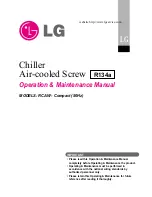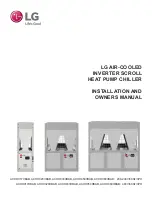
73
8.3 Sub-cooling and overheating calculation
Sub-cooling
1. De
fi
nition:
Difference between saturated condensation temperature
(TCD) and liquid line temperature (TLL).
SR = TCD - TLL
2. Required measurement equipment:
• Manifold
• Bulb or electronic thermometer (with temperature sensor)
• Filter or insulating foam
• Pressure-Temperature Conversion Table for R-407C.
3. Measurement steps:
1º) Place the thermometer bulb or sensor in contact with
the liquid line near the dryer fi lter (only for 120 size).
Assure the surface is clean. Cover the bulb or sensor
with foam, to isolate it from the ambient temperature.
2º) Install the manifold at the discharge (high manometer)
and suction (low manometer) lines.
3º) After the operation conditions stabilize, read the
pressure in the discharge line manometer.
4º) From R-407C table, get saturated condensation
temperature (TCD).
5º) Read the liquid line temperature (TLL) on the
thermometer. Subtract it from the saturated condensation
temperature; the difference is the sub-cooling.
6º) If the sub-cooling is between 8 and 11 °C,
the charge is correct. If it is below, add refrigerant; if it
is above, take away some refrigerant.
4. Calculation example:
- Discharge line pressure
(manometer)....................................20,34 Bar (295 psig)
- Saturated condensation temperature (table) ...........49°C
- Liquid line temperature (thermometer) ....................45°C
- Sub-cooling (subtraction) ..........................................4°C
Add refrigerant!
Overheating
1. De
fi
nition:
difference between suction temperature (ts) and
saturated evaporation temperature (tev).
SA = Ts - TEV
2. Required measurement equipment:
•
Manifold
• Bulb or electronic thermometer (with temperature
sensor)
• Filter or insulating foam
• Pressure-Temperature conversion table for R-407C.
3. Measurement steps:
1º) Place thermometer bulb or sensor in contact with the
suction line, the closest possible to the expansion valve
bulb. The surface shall be clean and the measurement
performed at the upper tube portion to prevent false
readings. Cover bulb or sensor with foam, to isolate
them from the ambient temperature.
2º) Install the manifold in the discharge (high manometer)
and suction (low manometer) lines.
3º) When the operation conditions stabilize, read the
pressure in the suction line manometer. From R-407C
table, get saturated evaporation temperature (TEV).
4º) Read the suction temperature (Ts) in the thermometer.
Perform several readings and calculate the average.
This will be the adopted temperature.
5º) Subtract the saturated evaporation temperature
(TEV) from the suction temperature: the difference is
overheating.
6º) If the overheating is between 4 and 6 °C, the expansion
valve setting is correct. If it is below, much refrigerant is
being injected into the evaporator and it is necessary to
close the valve (turn set screw to the right - clockwise). If
the overheating is high, little refrigerant is being injected
into the evaporator and it is necessary to open the valve
(turn set screw to left - counterclockwise).
4. Calculation example:
- Suction line pressure
(manometer) ......................................4,75 Bar (69 psig)
- Suction line temperature (thermometer)................. 15°C
- Saturated evaporation temperature (table) .............. 7°C
- Overheating (subtraction) ......................................... 8°C
High overheating: open the expansion valve!
Obs.: After to make V.E.T. adjustment don’t forget to replace
the helmet.
NOTE
Measurement shall be made with the equipment
operating within the installation project conditions to
allow achieving the desired performance.
Summary of Contents for 30AJ
Page 15: ...15 7 6 Diagramas El tricos Unidades 30AJ 220V...
Page 16: ...16 Unidades 30AJ 220V continua o...
Page 17: ...17 Unidades 30AJ 380V...




































